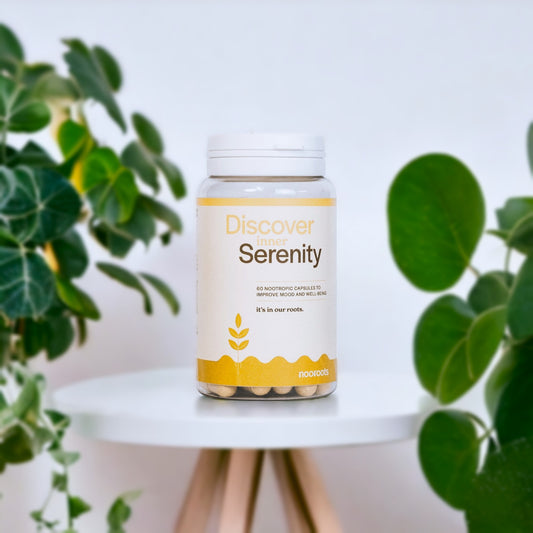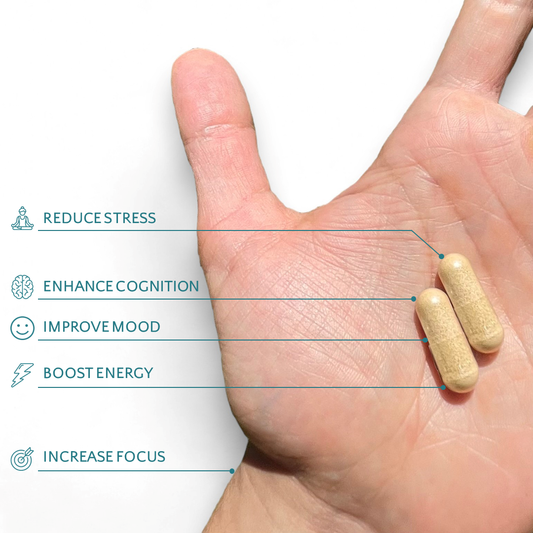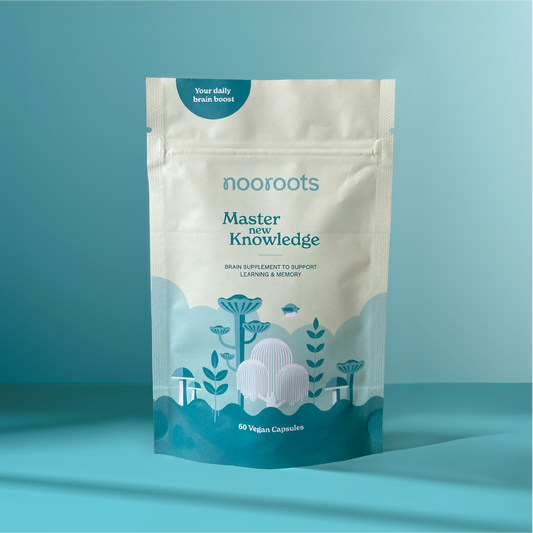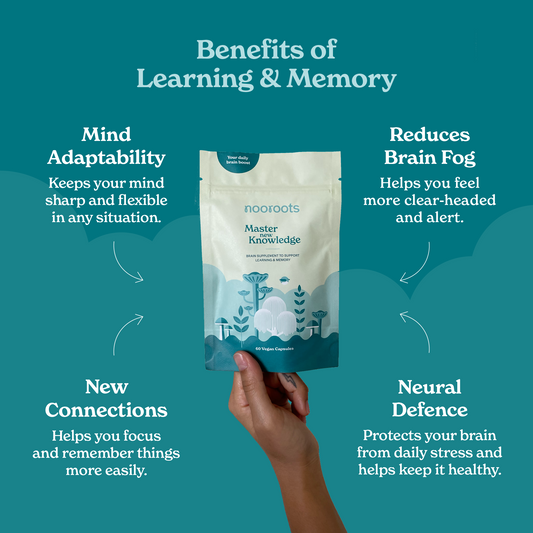Some natural nootropics fall into a category known as adaptogens—compounds recognized for their ability to help the body adapt to stress and maintain balance under challenging conditions. These substances, typically derived from plants and herbs, have been studied for their potential to modulate the physiological and psychological responses to stress in a gentle, non-pharmaceutical way.
Stress itself is a pervasive and multifaceted condition, influencing physical health, emotional wellbeing, and cognitive performance. Chronic stress has been associated with disrupted sleep, weakened immune function, impaired concentration, and an increased risk of cardiovascular and metabolic disorders. According to the American Psychological Association, approximately one in three adults in the United States report experiencing stress at levels that exceed what is considered healthy.
Conventional stress-management strategies often combine lifestyle adjustments—such as improved sleep hygiene, exercise, and mindfulness—with psychological therapies and, in some cases, pharmacological treatment. While medications can be effective for specific individuals, they may also carry risks including fatigue, dependency, and metabolic side effects such as weight fluctuations or appetite changes.
In contrast, natural adaptogens provide a promising complementary approach. Rather than directly altering mood or brain chemistry, they support the body’s inherent ability to maintain homeostasis when under pressure. Research suggests that many adaptogens influence the hypothalamic–pituitary–adrenal (HPA) axis and cellular stress-response pathways, enhancing resilience to both physical and emotional stressors without the sedative or dependency risks of conventional pharmaceuticals.
This article explores the scientific basis for natural adaptogens in stress management, highlights leading examples supported by research, and discusses practical ways to incorporate them into daily routines for improved mental clarity, endurance, and emotional balance.
Contents
- What is a Nootropic?
- The Neurobiology of Stress
- Deep Dive into the SAM and HPA Axes in the Stress Response
- Effect of Chronic Stress on the Brain
- What is an Adaptogen?
- How Adaptogens work?
- The Best Natural Nootropics for Stress Management
- Choosing the Right Nootropic
- Importance of a Healthy lifestyle
Using Nootropics to Combat Stress and Enhance Cognitive Function

What is a nootropic?
Nootropics—often referred to as “smart drugs” or cognitive enhancers—are substances known for their ability to improve aspects of mental performance such as memory, focus, motivation, and creativity. Their effects are mediated through the modulation of neural pathways and biochemical systems that influence cognitive processing, including neurotransmitters, enzymes, and energy metabolism within the brain.
The term nootropic was first introduced in the 1970s by Romanian chemist Dr. Corneliu E. Giurgea, who outlined several defining characteristics: enhancement of learning and memory, protection of the brain against physical or chemical injury, improvement in cortical and subcortical control mechanisms, and minimal side effects or toxicity. Since then, the field has expanded considerably to include both synthetic and natural compounds.
Synthetic nootropics are laboratory-developed molecules designed to target specific neural mechanisms. Many influence neurotransmitter systems—such as dopamine, acetylcholine, and glutamate—that are crucial for attention, working memory, and information processing. For example, piracetam, the first synthesized nootropic, has been shown to enhance synaptic plasticity and improve communication between the brain’s hemispheres, although its precise mechanism remains under study.
By contrast, natural nootropics originate from plants, herbs, or other natural sources and are often associated with centuries of traditional use. These compounds may improve cerebral blood flow, support mitochondrial energy production, or offer neuroprotective effects through antioxidant and anti-inflammatory actions. Well-studied examples include Ginkgo biloba, which has been shown to support memory and executive function in older adults, and Rhodiola rosea, an adaptogenic herb known to reduce mental fatigue and enhance resilience under stress.
While both synthetic and natural nootropics share the goal of optimizing cognitive performance, natural compounds are frequently favored for their broad, integrative benefits and lower risk of adverse effects. This holistic profile makes them particularly appealing for individuals seeking sustained cognitive support as part of a long-term wellness approach rather than short-term enhancement.
The Neurobiology of Stress
Stress, a universal feature of human experience, triggers a cascade of complex physiological and psychological responses. Its study has evolved considerably since the pioneering work of Walter Cannon, who introduced the concept of the fight-or-flight response, and Hans Selye, who defined stress as a non-specific biological reaction to any demand placed upon the body. Their foundational theories established the framework for contemporary neurobiological models of stress, which now integrate insights from neuroscience, endocrinology, and molecular biology.
At the core of this system lies a finely tuned network of brain structures that detect, interpret, and respond to potential threats. These include the amygdala, hippocampus, prefrontal cortex, and hypothalamus, each playing a distinct role in evaluating and regulating stress responses. When a stressor—whether physical or psychological—is perceived, these neural circuits rapidly activate two key physiological systems: the Sympathetic–Adreno–Medullary (SAM) axis and the Hypothalamic–Pituitary–Adrenal (HPA) axis.
The SAM axis mediates the immediate stress response, releasing catecholamines such as epinephrine and norepinephrine to prepare the body for action. This activation heightens alertness, increases heart rate, and mobilizes energy reserves—a coordinated process aimed at survival. Meanwhile, the HPA axis governs the slower, longer-term component of the stress response. Through the sequential release of corticotropin-releasing hormone (CRH), adrenocorticotropic hormone (ACTH), and glucocorticoids (such as cortisol), the HPA axis regulates energy balance, immune function, and cognitive adaptation.
Together, these systems maintain homeostasis in the face of adversity. However, chronic or repeated activation can lead to HPA axis dysregulation, resulting in persistently elevated cortisol levels. Such disruptions have been linked to an increased risk of depression, anxiety, metabolic disorders, and cognitive decline. Neuroimaging studies show that prolonged stress may alter the structure and function of key brain regions—particularly the hippocampus and prefrontal cortex—while sensitizing the amygdala, reinforcing a cycle of heightened stress reactivity.
Importantly, the brain’s ability to discriminate between different types of stressors—psychological versus physical—is critical for adaptive regulation. This differentiation allows the nervous system to tailor responses to the specific nature, duration, and intensity of the stressor. The interplay of neural circuits and signaling molecules over time underscores why stress can be both adaptive and harmful, depending on context and chronicity.
A comprehensive understanding of the neurobiology of stress is therefore central to identifying therapeutic targets for stress-related disorders and to developing interventions that enhance resilience—whether through behavioral, pharmacological, or natural means.

Deep Dive into the SAM and HPA Axes in Stress Response
The Sympathetic–Adreno–Medullary (SAM) axis and the Hypothalamic–Pituitary–Adrenal (HPA) axis systems coordinate immediate and sustained physiological reactions that enable the organism to respond effectively to environmental challenges.
The SAM Axis
The SAM axis mediates the body’s acute “fight-or-flight” response. When a stressor is perceived, sympathetic nerves stimulate the adrenal medulla to release epinephrine and norepinephrine. These catecholamines act rapidly to elevate heart rate, blood pressure, and blood glucose levels—mobilizing energy and sharpening focus.
Within the brain, the locus coeruleus (LC) is a central component of this pathway. Activation of the LC increases the release of norepinephrine across cortical and subcortical regions, enhancing vigilance and facilitating rapid behavioral responses. This system ensures that cognitive and physical resources are immediately available to meet external demands.
The HPA Axis
In contrast, the HPA axis governs the sustained or delayed stress response. Upon activation, the hypothalamus secretes CRH, which stimulates the anterior pituitary to release ACTH. ACTH then acts on the adrenal cortex, prompting the secretion of glucocorticoids—primarily cortisol in humans.
Cortisol acts on nearly every organ system, modulating glucose metabolism, immune function, and brain activity. In the central nervous system, it binds to glucocorticoid (GR) and mineralocorticoid receptors (MR), influencing gene transcription, neuronal excitability, and synaptic plasticity. While short-term glucocorticoid release supports adaptation, prolonged exposure can impair neurogenesis, reduce hippocampal volume, and disrupt emotional regulation.
Interaction Between SAM and HPA Axes
The SAM and HPA axes operate in dynamic interplay rather than isolation. CRH released by the hypothalamus not only triggers the HPA cascade but also activates the LC–norepinephrine system, facilitating communication between autonomic and endocrine components of the stress response. This cross-talk ensures an integrated physiological reaction—balancing rapid mobilization with longer-term recovery and adaptation.
Chronic stress, however, can disrupt this balance, leading to sustained sympathetic activation and impaired feedback inhibition of the HPA axis. The resulting dysregulation contributes to a spectrum of stress-related pathologies, from mood disorders to metabolic dysfunctions.

Effect of Chronic Stress on the Brain
Chronic stress exerts deep and lasting effects on the brain, reshaping both its structure and function through the prolonged activation of stress hormones—particularly glucocorticoids—and disruptions in neurotransmitter balance. Over time, these changes impair cognition, emotional regulation, and motivation, forming the neurobiological basis of many stress-related disorders.
Structural Changes
Prolonged stress leads to measurable remodeling in key brain regions:
- Hippocampus – Chronic exposure to glucocorticoids causes dendritic shrinkage and spine loss, reducing synaptic complexity. This atrophy impairs learning and memory formation.
- Prefrontal Cortex (PFC) – The medial PFC, essential for executive control and decision-making, exhibits dendritic retraction and reduced branching, which correlate with diminished attention, cognitive flexibility, and impulse regulation.
- Amygdala – In contrast, chronic stress promotes dendritic growth and increased spine density in the amygdala, heightening emotional reactivity and anxiety. This overactivation contributes to the development of mood and anxiety disorders, including PTSD.
These region-specific adaptations reflect the brain’s attempt to maintain homeostasis under prolonged stress—but at a cost to cognitive precision and emotional balance.
Functional Implications
The structural remodeling of these neural circuits produces significant functional deficits:
- Memory and Learning: Hippocampal atrophy disrupts the formation and retrieval of new memories.
- Executive Function: Impaired PFC signaling leads to poor concentration, impulsivity, and reduced problem-solving ability.
- Emotional Regulation: Amygdala hyperactivity amplifies fear and threat responses, sustaining anxiety and stress sensitivity.
- Motivation and Reward: Dysregulation of dopaminergic reward pathways diminishes motivation and pleasure, contributing to depressive symptoms.
Neurobiological Mechanisms
At the molecular level, chronic stress alters the balance of glucocorticoid and mineralocorticoid receptor activity, disrupting feedback regulation within the HPA axis. Sustained glucocorticoid exposure interferes with neurogenesis, reduces synaptic plasticity, and increases neuronal vulnerability to excitotoxicity.
Excess glutamate, the brain’s primary excitatory neurotransmitter, is a key mediator of stress-induced neural damage. Prolonged elevation of glutamate levels promotes dendritic retraction and can trigger neuronal loss, particularly in the hippocampus. These neurochemical imbalances create a feedback loop that reinforces both cognitive decline and emotional dysregulation under chronic stress.
What is an Adaptogen?
Adaptogens are a distinct class of bioactive plant compounds recognized for their ability to enhance the body’s resilience to a wide range of stressors—physical, emotional, and environmental. Unlike stimulants, which provide a temporary boost, adaptogens work through regulatory rather than specific effects, helping to restore physiological balance (homeostasis) and optimize the body’s response to stress over time.
The concept of adaptogens has deep roots in traditional Chinese medicine and Ayurveda, where certain herbs were historically valued for promoting vitality, endurance, and longevity. The modern term adaptogen was introduced by Nikolai Lazarev in 1947 and later refined by Israel Brekhman and colleagues in the mid-20th century, who defined adaptogens as substances that (1) increase the state of non-specific resistance to stress, (2) exhibit a normalizing effect regardless of the direction of change, and (3) are safe and non-toxic at normal doses.
Mechanistically, adaptogens influence the hypothalamic–pituitary–adrenal (HPA) axis, the sympathoadrenal system, and various neurotransmitter pathways, supporting a balanced stress response. Rather than suppressing or overstimulating physiological systems, they act to modulate them, promoting stability across endocrine, immune, and neural functions.
How Adaptogens work?
The effectiveness of adaptogens stems from their ability to modulate multiple biological systems that govern the body’s response to stress. Rather than acting through a single pathway, they operate as network regulators, restoring balance and stability across neuroendocrine, immune, and cellular processes. Their central goal is to promote homeostasis—the body’s capacity to maintain internal equilibrium under changing conditions.
Modulating the Stress Response
Adaptogens exert a major part of their action through regulation of the hypothalamic–pituitary–adrenal (HPA) axis and the sympathoadrenal system, both of which are essential to stress adaptation. By influencing the secretion and sensitivity of cortisol, the body’s primary stress hormone, adaptogens help normalize overactive or underactive stress responses. This modulation reduces the physiological burden of chronic stress and its downstream effects on mood, energy, and cognition.
Research shows that adaptogens enhance the body’s non-specific resistance to stress, supporting the recalibration of hormonal feedback loops and stabilizing autonomic nervous system activity. The result is improved tolerance to both physical and psychological stressors without the overstimulation associated with caffeine or amphetamine-like compounds.
Enhancing Neuroprotection and Cognitive Function
Adaptogens support brain health and resilience through neuroprotective, antioxidant, and anti-inflammatory actions. They help shield neurons from stress-induced damage by:
- Regulating neurotransmitters such as serotonin, dopamine, and norepinephrine—key mediators of mood, motivation, and attention.
- Promoting neuroplasticity, the brain’s ability to form and reorganize neural connections, essential for learning, memory, and adaptation.
- Preserving mitochondrial function and energy metabolism, ensuring sustained cognitive performance under fatigue.
Promoting Cellular Defense and Adaptation
At the cellular level, adaptogens stimulate protective mechanisms that improve endurance and recovery. One key process involves the upregulation of heat shock proteins (Hsp70)—molecular chaperones that maintain protein integrity under stress. Hsp70 helps repair damaged proteins, prevent cellular apoptosis, and maintain energy balance, contributing to the anti-fatigue and anti-depressive properties observed with adaptogen use.
These effects are reinforced by improved redox balance and mitochondrial efficiency, which reduce oxidative damage and support sustained energy production during
Acting as “Stress Vaccines”
Adaptogens have been described as “stress vaccines” or stress mimetics—compounds that gently activate stress-response pathways in a controlled manner. This mild preconditioning enhances the body’s readiness to handle future, more intense stressors. By training stress-regulatory systems through repeated low-level activation, adaptogens improve long-term stress tolerance and resilience, helping the body adapt more efficiently to both environmental and psychological challenges. prolonged stress exposure.
The Best Natural Nootropics for Stress Management
Natural nootropics and adaptogens provide an evidence-based approach to mitigating stress, enhancing cognitive resilience, and supporting long-term mental well-being. The following compounds have been among the most extensively studied for their effects on stress regulation, neuroprotection, and cognitive performance.
Ashwagandha
- Origin: A cornerstone of Ayurvedic medicine, Ashwagandha is native to India and North Africa and has been used for millennia to promote vitality and stress resistance.
- Mechanism: Ashwagandha regulates the hypothalamic–pituitary–adrenal (HPA) axis, reducing cortisol secretion and balancing stress-related neurochemistry. It also supports GABAergic signaling, which promotes relaxation and reduces neuronal excitability.
- Benefits: Helps promote calmness, emotional balance, and mental clarity by reducing stress-related tension and supporting relaxation. It is known to enhance energy levels, resilience, and overall well-being during periods of physical or emotional strain.
Holy Basil (Tulsi)
- Origin: An herb revered in Ayurvedic and Siddha medicine, Holy Basil is indigenous to the Indian subcontinent and considered a tonic for body and mind.
- Mechanism: Exhibits adaptogenic, anti-inflammatory, and immunomodulatory properties. It regulates cortisol levels and balances neurotransmitters involved in mood and stress resilience.
- Benefits: Supports emotional stability and cognitive clarity while promoting a sense of calm and balance. Its adaptogenic and antioxidant effects help protect against the physiological wear of stress, fostering long-term mental and physical resilience.
L-Theanine
- Origin: A naturally occurring amino acid found predominantly in green tea (Camellia sinensis) leaves.
- Mechanism: Modulates glutamate and GABA neurotransmission and promotes alpha-wave activity in the brain, associated with relaxed alertness. It also influences dopamine and serotonin levels.
- Benefits to Stress: Encourages a state of relaxed focus without sedation. It supports concentration, mood balance, and restful sleep while helping the body and mind recover from daily stress.
Rhodiola Rosea
- Origin: Native to the cold, high-altitude regions of Europe, Asia, and Alaska, Rhodiola has a long history of use in traditional medicine to combat fatigue and enhance endurance.
- Mechanism: Functions as an adaptogen by modulating the HPA axis and balancing monoamine neurotransmitters (serotonin, dopamine, norepinephrine). It also upregulates cellular energy metabolism and stress-response proteins.
- Benefits: Enhances endurance, concentration, and motivation under stress. It helps sustain mental performance and reduces fatigue, making it particularly beneficial for those facing ongoing psychological or physical demands.
Organic Cacao
- Origin: Derived from cacao beans, native to the tropical regions of Central and South America, and historically regarded as a “food of the gods.”
- Mechanism: Rich in flavonoids (especially epicatechin), cacao promotes nitric oxide synthesis, improving cerebral blood flow and offering neuroprotective antioxidant effects. It also influences serotonin and endorphin pathways associated with mood regulation.
- Benefits to Stress: Cacao supports positive mood, alertness, and overall brain function. Its rich antioxidant profile contributes to cardiovascular and cognitive health, indirectly promoting resilience against the effects of chronic stress.
Vitamins B Complex
- Origin: A group of water-soluble vitamins naturally present in foods such as whole grains, legumes, and leafy greens.
- Mechanism: Serve as cofactors in neurotransmitter synthesis (serotonin, dopamine, GABA) and energy metabolism, supporting healthy brain function during stress.
- Benefits to Stress: B vitamins help maintain balanced energy levels and emotional stability by supporting neurotransmitter function and healthy brain metabolism. They contribute to greater mental clarity, focus, and adaptability under stress.
Panax Ginseng
- Origin: An ancient herbal medicine originating from East Asia, particularly Korea and China, traditionally used to restore vitality and endurance.
- Mechanism: Acts on the HPA axis and monoaminergic systems, modulating stress hormone release and improving neuronal energy metabolism. Its active compounds, ginsenosides, enhance mitochondrial efficiency and antioxidant defense.
- Benefit: Panax Ginseng promotes sustained mental and physical energy while reducing fatigue. It enhances the body’s capacity to adapt to stress, supporting endurance, cognitive function, and overall vitality.
Lion’s Mane Mushroom (Hericium erinaceus)
- Origin: An edible and medicinal mushroom native to East Asia.
- Mechanism: Stimulates the synthesis of nerve growth factor (NGF), promoting neurogenesis and neuronal repair. It also reduces inflammation and oxidative stress in neural tissues.
- Benefit: Lion’s Mane supports mental clarity, mood balance, and cognitive performance. Its neurotrophic properties promote brain health and emotional resilience, helping the mind recover and adapt to long-term stress.

Choosing the Right Nootropic
Selecting the right nootropic is not simply about choosing a supplement—it’s about developing a thoughtful, personalized approach that aligns with your cognitive goals, health profile, and lifestyle. The following principles can help guide an effective and sustainable nootropic regimen.
Understand the Types
Nootropics fall broadly into two categories:
- Synthetic nootropics – Laboratory-formulated compounds such as racetams or certain stimulants, designed for targeted cognitive enhancement but sometimes associated with a higher potential for side effects.
- Natural nootropics – Plant- or amino acid–based compounds like Ginkgo biloba, Bacopa monnieri, and Rhodiola rosea. These typically offer broader, gentler effects with lower risk when used responsibly.
Understanding these distinctions helps in selecting a compound that suits both your desired outcomes and tolerance.
Prioritize Dosage and Consistency
Effectiveness depends on correct dosage and regularity. Underdosing can limit benefits, while excessive use may cause unwanted effects. Most natural nootropics require 2–3 weeks of consistent use before noticeable improvements emerge, and benefits often build gradually over time.
Always follow evidence-based dosage guidelines and allow the body to adapt rather than expecting immediate results.
Choosing the Right Form
Nootropics are available in several delivery forms—capsules, powders, tinctures, and teas.
- Capsules/tablets: Convenient and pre-measured.
- Powders: Allow flexible dosing and are often more cost-effective.
- Teas or tinctures: Preferred for herbal nootropics and gradual absorption.
Your choice should balance bioavailability, ease of use, and personal preference.
Explore Combinations Carefully
Some users enhance outcomes by “stacking”—combining complementary nootropics.
For example, L-theanine and caffeine are often paired to promote calm focus. However, combining compounds requires careful consideration of potential synergies, redundancies, and interactions.
Start with single ingredients to understand their effects before exploring combinations.
Monitor and Adjust
Track how you feel—mentally and physically. While most nootropics are well-tolerated, some individuals may experience restlessness, digestive changes, or sleep disturbances. If adverse effects occur, reduce dosage or pause use. Listening to your body is key to sustainable long-term benefits.
Seek Professional Guidance
Consult a qualified healthcare professional before starting or combining nootropics, especially if you:
- Take prescription medications
- Have existing medical conditions
- Plan to use synthetic or concentrated compounds
Professional input helps minimize risk and ensures compatibility with your overall health regimen.
Integrate Holistically
Nootropics deliver the greatest benefits when paired with a balanced lifestyle. Support cognitive performance through:
- A nutrient-rich diet
- Regular physical activity
- Adequate hydration and sleep
- Mindfulness or stress-reduction practices
A holistic approach creates the physiological foundation for nootropics to work effectively.
Verify Legality and Quality
Before purchasing, confirm that your chosen nootropics are legal in your region and sourced from reputable suppliers. Look for third-party testing or quality certifications to ensure product purity and potency.
By following these principles, you can navigate the world of nootropics with confidence—maximizing cognitive benefits, minimizing risk, and supporting long-term brain health through an informed, balanced approach.
Importance of a Healthy lifestyle
Nootropics can be powerful allies in enhancing cognition and resilience, but their true potential is realized only when built upon a solid foundation of healthy living. Sustainable mental performance and stress balance depend on an integrated approach that nurtures both brain and body through consistent, evidence-based habits.
The Integral Role of Lifestyle
Lifestyle choices—our daily routines, diet, sleep, movement, and mindset—shape the foundation of mental and physical health. The World Health Organization (WHO) estimates that up to 60% of factors influencing health and quality of life are directly linked to lifestyle behaviors. A holistic approach to wellness ensures that the brain’s biological systems are supported, allowing nootropics and adaptogens to work more effectively.
Key Lifestyle Components for Holistic Health
- Balanced Nutrition: A nutrient-rich diet fuels brain function, stabilizes mood, and supports the body’s stress response. Whole foods high in antioxidants, omega-3 fatty acids, vitamins, and minerals protect neurons and sustain cognitive clarity.
- Regular Exercise: Physical activity enhances circulation, supports neurogenesis, and improves sleep quality. Exercise also reduces stress hormones like cortisol and elevates mood-regulating neurotransmitters such as serotonin and dopamine.
- Quality Sleep: Restorative sleep consolidates memory, regulates emotion, and maintains hormonal balance. Prioritizing consistent sleep patterns and minimizing blue-light exposure before bed strengthens mental resilience and focus.
- Mindful Technology Managing screen time and incorporating digital breaks prevent overstimulation, improve attention span, and protect circadian rhythm. Intentional use of technology supports calmer, more focused cognitive states.
- Lifelong Learning and Mental Stimulation: Engaging in activities that challenge the mind—reading, learning new skills, or creative expression—keeps neural networks active, enhances plasticity, and reduces the risk of cognitive decline.
- Stress Management Practices: Techniques such as mindfulness, meditation, deep breathing, and time in nature help regulate the nervous system and restore emotional balance, promoting long-term adaptability to stress.

Conclusion
Nootropics offer a powerful means of enhancing cognitive performance and resilience by supporting the brain systems most affected by stress and anxiety. When used thoughtfully, they can help restore balance, improve focus, and strengthen the mind’s capacity to adapt under pressure.
By understanding the neurobiology of stress, the mechanisms of adaptogens, and the benefits of natural nootropics, it becomes clear that cognitive optimization is not achieved through supplementation alone but through an integrated approach that supports the whole person.
The most meaningful and sustainable benefits of nootropics emerge when they are combined with a healthy lifestyle—one grounded in balanced nutrition, consistent physical activity, restorative sleep, and effective stress management. Together, these elements form a comprehensive strategy for long-term mental clarity, emotional stability, and overall well-being.
For those interested in taking the first step, our Learning & Memory Nootropic Supplement at Nooroots offers a carefully formulated introduction to the world of cognitive enhancement—crafted to support both clarity of mind and balance of mood.
Continue exploring the science of smarter nutrition with these related reads:
References:
- American Psychological Association. (2023). Stress in America: The State of Our Nation.
- Beck, S., Ruge, H., Schindler, C., Burkart, M., Miller, R., Kirschbaum, C., & Goschke, T. (2016). Effects of Ginkgo biloba extract EGb 761® on cognitive control functions, mental activity of the prefrontal cortex and stress reactivity in elderly adults with subjective memory impairment – a randomized double‐blind placebo‐controlled trial. Human Psychopharmacology: Clinical and Experimental, 31(3), 227–242. https://doi.org/10.1002/hup.2534
- Brekhman, I. I., & Dardymov, I. V. (1969). New substances of plant origin which increase nonspecific resistance. Annual Review of Pharmacology, 9(1), 419–430. https://doi.org/10.1146/annurev.pa.09.040169.002223
- Cannon, W. B. (1932). The Wisdom of the Body. W.W. Norton & Company.
- Godoy, L. D., Rossignoli, M. T., Pereira, P. D., Garcia‐Cairasco, N., & De Lima Umeoka, E. H. (2018). A comprehensive overview on stress Neurobiology: basic concepts and clinical implications. Frontiers in Behavioral Neuroscience, 12. https://doi.org/10.3389/fnbeh.2018.00127
- Hidese, S., Ogawa, S., Ota, M., Ishida, I., Yasukawa, Z., Ozeki, M., & Kunugi, H. (2019). Effects of L-Theanine Administration on Stress-Related Symptoms and Cognitive Functions in healthy adults: a randomized controlled trial. Nutrients, 11(10), 2362. https://doi.org/10.3390/nu11102362
- Impact of lifestyle on health. (2015, November 1). PubMed. https://pubmed.ncbi.nlm.nih.gov/26744700/
- Jamshidi, N., & Cohen, M. (2017). The clinical efficacy and safety of Tulsi in humans: A Systematic Review of the literature. Evidence-based Complementary and Alternative Medicine, 2017, 1–13. https://doi.org/10.1155/2017/9217567
- Katz, D. L., Doughty, K. N., & Ali, A. (2011). Cocoa and chocolate in human health and disease. Antioxidants & Redox Signaling, 15(10), 2779–2811. https://doi.org/10.1089/ars.2010.3697
- Kühn, S., Düzel, S., Colzato, L. S., Norman, K., Gallinat, J., Brandmaier, A. M., Lindenberger, U., & Widaman, K. F. (2017). Food for thought: association between dietary tyrosine and cognitive performance in younger and older adults. Psychological Research, 83(6), 1097–1106. https://doi.org/10.1007/s00426-017-0957-4
- Lupien, S. J., et al. (2009). Effects of stress throughout the lifespan on the brain, behaviour and cognition. Nature Reviews Neuroscience, 10(6), 434–445. https://doi.org/10.1038/nrn2639
- McEwen, B. S. (2017b). Neurobiological and systemic effects of chronic stress. Chronic Stress, 1, 247054701769232. https://doi.org/10.1177/2470547017692328
- McEwen, B. S. (2007). Physiology and neurobiology of stress and adaptation: Central role of the brain. Physiological Reviews, 87(3), 873–904. https://doi.org/10.1152/physrev.00041.2006
- McEwen, B. S., & Morrison, J. H. (2013). The brain on stress: Vulnerability and plasticity of the prefrontal cortex over the life course. Neuron, 79(1), 16–29. https://doi.org/10.1016/j.neuron.2013.06.028
- Malík, M., & Tlustos, C. (2022). Nootropics as cognitive enhancers: Types, dosage and side effects of smart drugs. Nutrients, 14(16), 3367. https://doi.org/10.3390/nu14163367
- Panossian, A., & Wikman, G. (2010). Effects of Adaptogens on the Central Nervous System and the Molecular Mechanisms Associated with Their Stress—Protective Activity. Pharmaceuticals, 3(1), 188–224. https://doi.org/10.3390/ph3010188
- Popoli, M., Yan, Z., McEwen, B. S., & Sanacora, G. (2012). The stressed synapse: The impact of stress and glucocorticoids on glutamate transmission. Nature Reviews Neuroscience, 13(1), 22–37. https://doi.org/10.1038/nrn3138
- Selye, H. (1936). A syndrome produced by diverse nocuous agents. Nature, 138, 32. https://doi.org/10.1038/138032a0
- Stojcheva, E. I., & Quintela, J. C. (2022). The Effectiveness of Rhodiola rosea L. Preparations in Alleviating Various Aspects of Life-Stress Symptoms and Stress-Induced Conditions—Encouraging Clinical Evidence. Molecules, 27(12), 3902. https://doi.org/10.3390/molecules27123902
- Ulrich-Lai, Y. M., & Herman, J. P. (2009). Neural regulation of endocrine and autonomic stress responses. Nature Reviews Neuroscience, 10(6), 397–409. https://doi.org/10.1038/nrn2647
- Vyas, A., Mitra, R., Shankaranarayana Rao, B. S., & Chattarji, S. (2002). Chronic stress induces contrasting patterns of dendritic remodeling in hippocampal and amygdaloid neurons. Journal of Neuroscience, 22(15), 6810–6818. https://doi.org/10.1523/JNEUROSCI.22-15-06810.2002
- Young, L. M., Pipingas, A., White, D., Gauci, S., & Scholey, A. (2019). A Systematic Review and Meta-Analysis of B Vitamin Supplementation on Depressive Symptoms, Anxiety, and Stress: Effects on Healthy and ‘At-Risk’ individuals. Nutrients, 11(9), 2232. https://doi.org/10.3390/nu11092232





